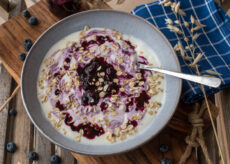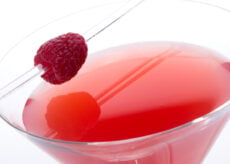Coach Cristina’s Immunity Boosting Fire Cider Recipe

The world is abuzz with immunity-boosting foods right now. Word on the street is that vitamin C is almost harder to find than toilet paper. The health-minded individuals who have already adopted the practice of including apple cider vinegar (ACV) in their morning routine are already on fire, so it makes sense that Fire Cider would be catching on too.
Aside from adhering to a healthful diet full of fruits and vegetables, getting plenty of rest, washing your hands, keeping your hands to yourself (social distancing), and refraining from touching your face, is there any truth to herbal blends helping keep the germs and viruses from invading your space or at least your body?
Herbalist Rosemary Gladstar would say so. She is the creator of Fire Cider, which she first concocted in 1970, using a base of ACV, then adding some basic herbs and honey to finish it off. She allowed her mixture to ferment/marry for several weeks, and the result is something that will touch all of your tastes buds. There is heat, sweet, and sour, and I would recommend either mixing it into a beverage of your choice or following it up with a cup of water—sort of like a chaser, if you will.
I decided to try some ready-made Fire Ciders, so I could get the feel for what this is supposed to taste like, and then I created my own. After sampling a few, I decided you really cannot go wrong with what you add, and you can design it to cure what ails you or to fit your taste preference.
Key Fire Cider Ingredients
Here are some examples of what you can add to your fire cider and the potential health benefits associated with them:
Apple Cider Vinegar. There are several ways apple cider vinegar may help boost your immune system. It is fermented, which means it contains beneficial bacteria and prebiotics, which may have a positive impact on immune health. (As the saying goes, “A healthy immune system starts with a healthy gut.”) It also appears to have antibacterial properties, which may help prevent pathogens from wreaking havoc in your body. ACV also may encourage detoxification through lymphatic drainage and enhanced circulation, which can help the body remove the bad bugs more quickly.
Garlic. Garlic contains compounds that may support the immune system in its fight against germs. Whole garlic contains a compound called alliin, which turns into allicin once garlic is crushed or chewed. Because allicin is unstable, it can rapidly convert to other sulfur-containing compounds thought to give garlic its healing benefits. These compounds have been shown to help boost the disease-fighting response of some types of white blood cells in the body when viruses are encountered (including those that cause the common cold or flu).
Ginger. With potential anti-inflammatory and antioxidant effects, ginger may help boost immune health. Acute inflammation is an important part of normal immune response. Unfortunately, if inflammation becomes chronic, it can harm the immune system and can even increase the chance of becoming ill. Increasing the intake of antioxidant-rich foods and beverages like ginger may help combat that inflammation and, in turn, help keep your immune system healthy.
Horseradish. Packed with a powerful punch of flavor, horseradish also provides beneficial nutrients, including essential minerals and phytochemicals, which give the root its well-known pungent aroma. Some compounds found in horseradish are antioxidants that may help stimulate the body’s white blood cell supply to help protect us from illness. Horseradish is also high in vitamin C, which is known to help boost the body’s immunity, which is key for overall health and helping prevent illness.
Cayenne Pepper. Along with other spicy peppers, cayenne is a warming spice that can potentially help ward off sickness. It provides antioxidants, vitamin A, and capsaicin, which may help destroy bacteria and viruses. Cayenne pepper is also helpful for boosting metabolism, improving digestion, and potentially reducing pain.
Turmeric. This spice is well-known for supporting the health of a robust immune system through its antioxidant, anti-inflammatory, and anti-microbial properties. All of these benefits are entirely thanks to the active compound found inside of turmeric’s rhizomatous root called curcumin. Curcumin may help support immune health by helping the body defend itself and function optimally.
Other ingredients I have thrown into the mixture at times are rosemary, jalapeños, peppercorns, cinnamon sticks, lemon, and orange. One of the Fire Ciders I sampled has Carolina Reaper peppers in it, and boy did that provide some additional pep in my step!
The following recipe incorporates a little bit of this and a little bit of that all to help put a bit of fire into your immune system and metabolism. I hope you enjoy it as much as I do!
Coach Cristina’s Fire Cider Recipe
Ingredients:
- 1/4 cup garlic, freshly chopped
- 1/4 cup ginger, freshly chopped
- 1/4 cup horseradish, freshly chopped
- 2 dried hot chiles, crushed or freshly chopped
- 1 Tbsp turmeric, ground or freshly grated
- 1/2 tsp black peppercorns, crushed
- 1 orange, washed and quartered
- 1 lemon, washed and quartered
- ACV (preferably with The Mother, which is the cloudy, darker sediment at the bottom of the bottle) to cover
- Honey, to taste
Directions:
Step 1) In a clean quart jar, add garlic, ginger, horseradish, chiles, turmeric, and peppercorns. Then squeeze the orange and lemon juice into the mixture before adding the rinds. Stir well, then press the solids down until they’re firmly packed.
Step 2) Pour the ACV into the quart jar until the solids are covered completely. Avoid filling the jar to the very brim. If the lid is metal, use a square of parchment paper to cover the top of the jar before tightly sealing the lid. (Metal can react weirdly with vinegar, and no one wants that.)
Step 3) For quick fire cider: Transfer the quart jar to the fridge and let it steep for at least 12 hours. Before drinking, use a wooden spoon to again press down on the herbs to help release more flavor. Pour some into a shot glass and mix in honey to taste. Take a shot every morning or whenever you’re feeling under the weather. Just make sure you finish the bottle within a month.
Step 4) For slow fire cider: Transfer the jar to a cool, dark area in the kitchen (e.g., a pantry or cabinet). Let the mixture steep but pull it out to gently shake the jar once a day for three weeks. Using a wooden spoon, press down the herbs to extract the full flavor. Then remove any solids before adding in honey to taste. Toss or compost the solids and then transfer the cider to the fridge. Again, you can enjoy a shot every morning or whenever you’re feeling under the weather. Just make sure you finish the jar within a month.




 7 Signs Your Body is Seriously Low on Collagen (not just wrinkles)
7 Signs Your Body is Seriously Low on Collagen (not just wrinkles) Health Expert: "Turmeric Doesn't Work (unless...)"
Health Expert: "Turmeric Doesn't Work (unless...)" 3 Warning Signs Your Probiotic Supplement is a Total Waste
3 Warning Signs Your Probiotic Supplement is a Total Waste

